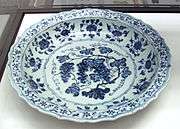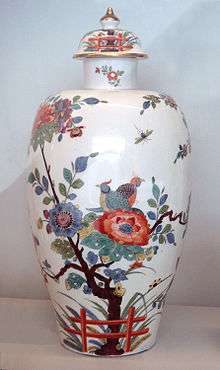Royal Copenhagen
 | |
| Porcelain Manufacturer | |
| Founded | 1 May 1775 |
| Headquarters | Denmark, Copenhagen |
| Parent | Fiskars |
| Website | Royal Copenhagen |
Royal Copenhagen, officially the Royal Porcelain Factory (Danish: Den Kongelige Porcelænsfabrik), is a manufacturer of porcelain products and was founded in Copenhagen 1 May 1775 under the protection of Queen Juliane Marie. It is recognized by its factory mark, the three wavy lines above each other, symbolizing Denmark’s three straits: Øresund, the Great Belt and the Little Belt.[1]
Early years

Starting in the 17th century, Europeans were fascinated by the blue and white and white porcelain exported from China during the Ming and Qing dynasties,.[2]
The Royal Copenhagen manufactory operations began in a converted post office in 1775. It was founded by a chemist, Frantz Heinrich Müller, who was given a 50-year monopoly to create porcelain. The first pieces manufactured were dining services for the royal family.[3] When, in 1779, King Christian VII assumed financial responsibility, the manufactory was styled the Royal Porcelain Factory. In 1790, Royal Copenhagen brought out its now famous Flora Danica ‘Blue Fluted’ dinner service, with gilded edge and Danish flora motifs,[4] and Royal Copenhagen held a monopoly on the "Blue Fluted" name.[5]
By 1851, Royal Copenhagen qualified for the World Expo in London. In 1868, as a result of royal companies' privatization, the Royal Porcelain Factory came into private hands. It was purchased by the faience factory Aluminia in 1882. Shortly after Aluminia's acquisition, Royal Copenhagen production was moved to a modern factory building at Aluminia’s site in Frederiksberg, on the outskirts of Copenhagen. By 1889, Royal Copenhagen qualified for the World Expo in Paris, winning the Grand Prix, giving it international exposure.
Current company
In recent years, Royal Copenhagen acquired Georg Jensen in 1972, incorporated with Holmegaard Glass Factory in 1985, and finally Bing & Grøndahl in 1987. Royal Copenhagen was a part of a group of Scandinavian companies, Royal Scandinavia, together with Georg Jensen, and was owned by the Danish private equity fund, Axcel. Following Axcel's acquisition of Royal Scandinavia, Holmegaard Glasværk was sold in a MBO and a controlling interest in the Swedish glass works Orrefors Kosta Boda was sold to New Wave Group.
In December 2012 Axcel sold Royal Copenhagen to the Finnish listed company Fiskars, which was founded in 1649.[6]
The company now produces its products in Thailand.[7][8][9]
Patterns (original manufacturer in parentheses)

Most famous
- Flora Danica, Blue Fluted (in Danish: Musselmalet), Blue Flower, Henriette, Saxon Flower, Fan, Gemina, and Gemma (Royal Copenhagen)
- Empire, Offenbach, Butterfly and Seagull (Bing & Grøndahl)
- Tranquebar and Blue Line (Aluminia).
New
- Black Mega, Palmette, White Plain, White Half Lace, White Full Lace, Blue Flower Curved and Plain, White Pot, Blue Line, the new Christmas service Star Fluted, and Ole.[10]
Discontinued
- Blue Flower, Gemina, Gemma, Jingle Bells, and Julian Marie (Royal Copenhagen)
- Seagull, Blue Henning Koppel, White Henning Koppel, Tema, Mexico (Bing & Grøndahl)
Collectables
- Royal Copenhagen 2010 plaquettes: Numbered and named cobalt blue decorated plates depicted a variety of scenes, holidays, years, and occasions. Most commonly round, they measured about 8 cm (3-1/4") in diameter, with a blue scene on white background.
- Larger, approximately 18.5 cm, blue on white cobalt blue decorated plates, created annually for Mother's Day, the Olympics and other commemorations. Some weren't annual issues, instead depicted scenes. In 1895, Royal Copenhagen began producing annual Christmas plates, and continue to do so.[11]
- Porcelein pipes, beginning in 1969 and manufactured for about 15 years.
Christmas plates
The tradition of Christmas plates started hundreds of years ago in Europe, when wealthy people presented their servants with cakes and sweets, served on decorative plates of wood or metal at Christmas time. The servants referred to these gifts as their Christmas Plate. In 1895 Bing & Grøndahl produced the first Christmas plate made from porcelain, with the date inscribed, and has made one each year since. In 1908 the Royal Copenhagen factory followed suit. Each year these plates are made in limited quantities and have been collectable for over 100 years. Each plate is made in the year of issue only, after which the mould is destroyed, and the design is never made again.[12]
The themes since 1908 are:[13]
| Year | Christmas Plate | Notes |
|---|---|---|
| 1908 | Madonna & Child | |
| 1909 | Danish Landscape | |
| 1910 | The Magi | |
| 1911 | Thief Plate | |
| 1911 | Landscape | |
| 1912 | Christmas Tree | |
| 1913 | Frederiks Kirke | Frederik's Church |
| 1914 | Helligåndskirken | Church of the Holy Ghost |
| 1915 | Danish Landscape | |
| 1916 | Shepherds in the Field | |
| 1917 | Vor Frelsers Kirke | Church of Our Saviour, Christianshavn |
| 1918 | The Shepherds | |
| 1919 | In The Park | |
| 1920 | Mary & Child | |
| 1921 | Aabenraa Market | |
| 1922 | Three Singing Angels | |
| 1923 | Landscape | |
| 1924 | Sailing Ship | |
| 1925 | Christianshavn | |
| 1926 | Christianshavns Kanal | |
| 1927 | Ship's Boy at Tiller | |
| 1928 | Vicar's Family | |
| 1929 | Grundtvigs Kirke | Grundtvig's Church |
| 1930 | Fishing Boats | |
| 1931 | Mother & Child | |
| 1932 | Frederiksberg | |
| 1933 | Storebæltsfærgerne | Great Belt ferries |
| 1934 | Eremitageslottet | Hermitage Hunting Lodge |
| 1935 | Kronborg | |
| 1936 | Roskilde Domkirke | Roskilde Cathedral |
| 1937 | Copenhagen | |
| 1938 | Østerlars Church | |
| 1939 | Ship on Greenland Ice | |
| 1940 | The Good Shepherd | |
| 1941 | Village Church | |
| 1942 | Bell Tower | |
| 1943 | Flight Into Egypt | |
| 1944 | Winter Scene | |
| 1945 | Peaceful Motif | |
| 1946 | Zealand Church | |
| 1947 | The Good Shepherd | |
| 1948 | Nødebo Kirke | Nødebo Church |
| 1949 | Vor Frue Kirke | Church of Our Lady |
| 1950 | Boeslunde Church | |
| 1951 | Christmas Angel | |
| 1952 | Christmas In The Forest | |
| 1953 | Frederiksberg | |
| 1954 | Amalienborg | |
| 1955 | Fano Girl | |
| 1956 | Rosenborg Slot | Rosenborg Castle |
| 1957 | The Good Shepherd | |
| 1958 | Grønland | Greenland |
| 1959 | Christmas Night | |
| 1960 | The Stag | |
| 1961 | Training Ship Denmark | |
| 1962 | Den lille havfrue | The Little Mermaid |
| 1963 | Højsager Mill | |
| 1964 | Fetching The Tree | |
| 1965 | Little Skaters | |
| 1966 | The Blackbird At Christmas | |
| 1967 | The Royal Oak | |
| 1968 | The Last Umiak | |
| 1969 | Old Farmyard | |
| 1970 | Christmas Rose & Cat | |
| 1971 | Hare In Winter | |
| 1972 | In The Desert | |
| 1973 | Train Homeward Bound | |
| 1974 | Owl | |
| 1975 | Marselisborg Slot | Marselisborg Palace |
| 1976 | Vibaek Mill | |
| 1977 | Immervad Bridge | |
| 1978 | Greenland Scene | |
| 1979 | Choosing The Tree | |
| 1980 | Bringing Home The Tree | |
| 1981 | Admiring The Tree | |
| 1982 | Waiting For Christmas | |
| 1983 | Merry Christmas | |
| 1984 | Jingle Bells | |
| 1985 | The Snowman | |
| 1986 | Christmas Holidays | |
| 1987 | Winter Birds | |
| 1988 | Copenhagen Skyline | |
| 1989 | Old Skating Pond | |
| 1990 | Tivoli Gardens | |
| 1991 | Santa Lucia Fest | |
| 1992 | The Royal Coach | |
| 1993 | Arriving Train | |
| 1994 | Home From Shopping | |
| 1995 | The Manor House | |
| 1996 | Street Lamps | |
| 1997 | Roskilde Domkirke | Roskilde Cathedral |
| 1998 | Boat Scene | |
| 1999 | The Sleigh Ride | |
| 2000 | Trimming The Tree | |
| 2001 | Watching The Birds | |
| 2002 | Winter In The Forest | |
| 2003 | Seasons Greetings | |
| 2004 | Awaiting The Christmas Train | |
| 2005 | Hans Christian Andersen House | |
| 2006 | Kronborg | |
| 2007 | Christmas in Nyhavn | |
| 2008 | Copenhagen Christmas | |
| 2009 | Christmas at Amagertorv | Amager Square |
| 2010 | Christmas in Greenland | |
| 2011 | Waiting For Santa Claus | |
| 2012 | Sailing The North Sea | |
| 2013 | Copenhagen Harbour | |
| 2014 | Hans Christian Andersen |
Further reading
- Bojesen, Benedicte, and Steen Nottelmann. Royal Copenhagen Art, Industry. Lyngby: Sophienholm, 1996. ISBN 87-87883-57-0
- Christoffersen, Lars. Christmas Plates & Other Commemoratives from Royal Copenhagen and Bing & Grøndahl. A Schiffer book for collectors. Atglen, PA: Schiffer Pub, 2004. ISBN 0-7643-2089-0 Table of contents
- Heritage, Robert J. Royal Copenhagen Porcelain Animals and Figurines. A Schiffer book for collectors. Atglen, PA: Schiffer Pub, 1997. ISBN 0-7643-0101-2
- Kongelige Porcelainsfabrik, Bredo L. Grandjean, Dyveke Helsted, and Merete Bodelsen. The Royal Copenhagen Porcelain Manufactory 1775-1975. Copenhagen: The Manufactory, [eksp., Amagertorv 6], 1975. ISBN 87-980342-1-9
- Pope, Caroline, and Nick Pope. A Collector's Guide to Royal Copenhagen Porcelain. A Schiffer book for collectors. Atglen, PA: Schiffer, 2001. ISBN 0-7643-1386-X
- Wagner, Peter, Steen Nottelmann, Finn Andersen, and Paul Nesbitt. Flora Danica. Edinburgh: Royal Botanic Garden, Edinburgh, 1994. ISBN 0-9523869-0-9
- Winstone, H. V. F. Royal Copenhagen. [London]: Stacey International, 1984. ISBN 0-905743-37-7
See also
References
- ↑ "History timeline". Royal Copenhagen. Archived from the original on 2008-01-02. Retrieved 2007-08-19.
- ↑ Lu Chenglong. "A Brief Introduction to Chinese Ceramics in Sweden". Gotheborg.com. Retrieved 2007-08-19.
- ↑ "Danish Porcelain Pipes". Danishpipemakers.com. Retrieved 2015-10-28.
- ↑ Archived August 17, 2007, at the Wayback Machine.
- ↑
- ↑ Archived March 16, 2014, at the Wayback Machine.
- ↑ "Royal Copenhagen Makes Moves into Thailand". Scandasia.com. Retrieved 2015-10-28.
- ↑ Ministry of Foreign Affairs of Denmark. "ROYAL COPENHAGEN TO THAILAND". Denmark.dk. Archived from the original on 2008-05-03. Retrieved 2008-04-11.
- ↑ "Field trip to Royal Copenhagen Thailand". Scandasia.com. Retrieved 2015-10-28.
- ↑ "Royal Copenhagen". RoyalCopenhagen.com. Retrieved 2015-10-28.
- ↑ "Danish Porcelain Pipes". Danishpipemakers.com. Retrieved 2015-10-28.
- ↑ "Empire Gifts - More Info about **Royal Copenhagen Christmas Plates from 1908 to 2014". Empiregiftsandantiques.com. Retrieved 2015-10-28.
- ↑ "Royal Copenhagen :: Royal Copenhagen/Christmas Plates (1908-2015)". GeolinOnline.com. Retrieved 2015-10-28.
External links
![]() Media related to Royal Copenhagen at Wikimedia Commons
Media related to Royal Copenhagen at Wikimedia Commons

